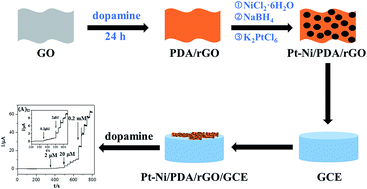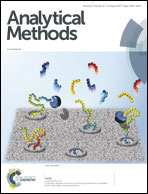A high-performance electrochemical dopamine sensor based on a platinum–nickel bimetallic decorated poly(dopamine)-functionalized reduced graphene oxide nanocomposite†
Abstract
A nanocomposite of platinum–nickel bimetallic decorated poly(dopamine)-functionalized reduced graphene oxide (Pt–Ni/PDA/rGO) was prepared by a facile and attractive method. Furthermore, a high-performance electrochemical sensor for the detection of dopamine was fabricated by dropping the Pt–Ni/PDA/rGO nanocomposites on a glassy carbon electrode. The morphology and composition of the Pt–Ni/PDA/rGO nanocomposites were characterized by field emission-scanning electron microscopy, transmission electron microscopy, X-ray powder diffraction, energy-dispersive X-ray spectroscopy, Raman microscopy and X-ray photoelectron spectroscopy. Electrochemical impedance spectroscopy, cyclic voltammetry and chronoamperometry were used to investigate the electrochemical behavior of the Pt–Ni/PDA/rGO nanocomposites. The linear range and detection limit were 0.2–911 μM and 0.07 μM, respectively. The sensitivity of this non-enzymatic dopamine sensor was calculated to be 912.8 μA mM−1 cm−2. Moreover, the Pt–Ni/PDA/rGO nanocomposite-modified GCE also showed good anti-interference ability and stability.



 Please wait while we load your content...
Please wait while we load your content...